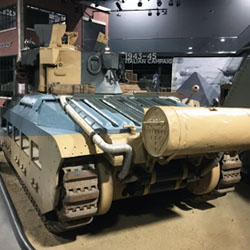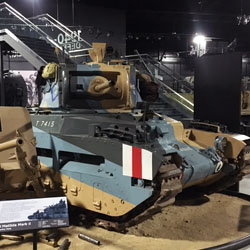The Matilda was a British infantry tank used in World War Two. With its heavy armor, the Matilda II was an excellent infantry support tank but with somewhat limited speed and armament. It was the only British tank to serve from the start of the war to its end, although it is particularly associated with the North Africa Campaign. It was replaced in front-line service by the lighter and less costly Infantry Tank Mk III Valentine beginning in late 1941.
The Matilda weighed around 27 tons and was armed with an Ordnance QF 2-pounder (40 mm) tank gun in a three-man turret. The turret traversed by hydraulic motor or by hand through 360 degrees; the gun could be elevated through an arc from −15 to +20 degrees. One of the most serious weaknesses of the Matilda II was the lack of a high-explosive round for its main gun. The main weapon against un-armored targets was its machine gun.
Like many other British infantry tanks, the armor of the Matilda was the heaviest of its era. While the Matilda possessed a degree of protection that was unmatched in the North African theater, the sheer weight of the armor on the vehicle contributed to a very low average speed of about 6 mph on desert terrain and 16 miles per hour on roads. The slow speed of the Matilda was further exacerbated by a troublesome suspension and a comparatively weak power unit, which was created from two AEC 6-cylinder bus engines linked to a single shaft. The front armor of the Matilda was up to 3.1” in thick; the nose plates top and bottom were thinner but angled. The sides of the hull were 2.6 to 2.8 in and the rear armor, protecting the engine to sides and rear, was 2.2” thick.
The Matilda served in all theaters during WWII but received most of its notoriety in North Africa. The Matilda proved highly effective against Italian and German tanks, although vulnerable to the larger caliber and medium caliber anti-tank guns. In late 1940, during Operation Compass, Matildas of the British 7th Armored Division wreaked havoc among the Italian forces in Egypt. The Italians were equipped with L3 tankettes and M11/39 medium tanks, neither of which had any chance against the Matildas. Italian gunners were to discover that the Matildas were impervious to a wide assortment of artillery. Matildas continued to confound the Italians as the British pushed them out of Egypt and entered Libya to take Bardia and Tobruk. Even as late as November 1941, German infantry combat reports show the impotence of ill-equipped infantry against the Matilda. The true nemesis for the Matilda (and every tank at that) was the German 88mm gun whose shell would easily penetrate the thick armor. The devastation from the 88 was seen during Operation Battleaxe, when sixty-four Matildas were lost. Nevertheless, during Operation Crusader Matilda tanks of 1st and 32nd Army Tank Brigades were instrumental in the break-out from Tobruk and the capture of the Axis fortress of Bardia.






